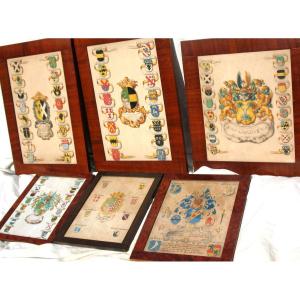"6 Gouaches With Heraldic Decoration Signed Horst Genealogy With Coats Of Arms Of Joan Loten Ep. 18th"
Set of 6 gouaches with 18th century heraldic decoration The last of the set is dated and signed H. Horst 1751 (below a cartouche) Some gouaches are decorated on the edges with 16 coats of arms on either side of the central coat of arms Entirely hand painted with extreme finesse worthy of a miniaturist Coat of arms with swans, griffins, crests with thistles, sheep and fleur-de-lis.... In the center large coat of arms of the family of Joan Gideon Loten One is dated October 26, 1733, another from December 8, 1689 Very good general condition, very slight wear Rare documents from a Dutch family Superb quality of execution Very fresh colors: royal blue and soft green... Leaf gilding Letters to Indian ink Framed in a mahogany frame for some 20th century frame made by Gerbrands in Utrecht 2 Views: h: 53.3 cm width: 35 cm 2 Frames h: 66.2 cm width: 48 cm 1 View: 44, 6 x 36.5 cm 1 frame: 57.7 x 49.6 cm 1 view: 38.5 x 29 cm 1 frame: 46.5 x 37 cm 1 view: 37.4 x 26.5 cm 1 frame: 43 .4 x 32.6 cm 1 view: 27.5 x 37.5 cm 1 frame: 33 x 43.5 cm Other photos available on request For info: Joan Gideon Loten (born May 16, 1710 – died February 25, 1789 listen)) was a Dutch colonial administrator and naturalist, governor of Dutch Ceylon from 1752 to 1757. He was educated at the University of Utrecht and arrived in India in 1732 as a member of the Dutch East India Company. First Governor of Makassar (1744-1750), he was appointed Governor of Batavia, Ceylon and the Celebes archipelago on September 10, 1752, a position he held until March 17, 1757. In Colombo, he collected many zoological and botanical specimens that Pieter Cornelius de Bevere and Peter Brown painted and drew, a collection that would later be entrusted to the Natural History Museum in London. Returning to the Netherlands in 1758, he moved to London in 1759 where he remained for twenty-two years but had to leave the country in 1781 after the outbreak of the Anglo-Dutch wars. He then resettled in Utrecht where he ended his life. He was buried in Jacobikerk and a monument in his honor was erected by Thomas Bank in 1795 in Westminster Abbey. A species of bird bears his name: the Loten Sunbird. An inventory of his natural history drawings is in the London Natural History Museum and the Teylers Museum in Haarlem – to this day a valuable treasure trove of the 18th century natural history of Sri Lanka and Indonesia.



